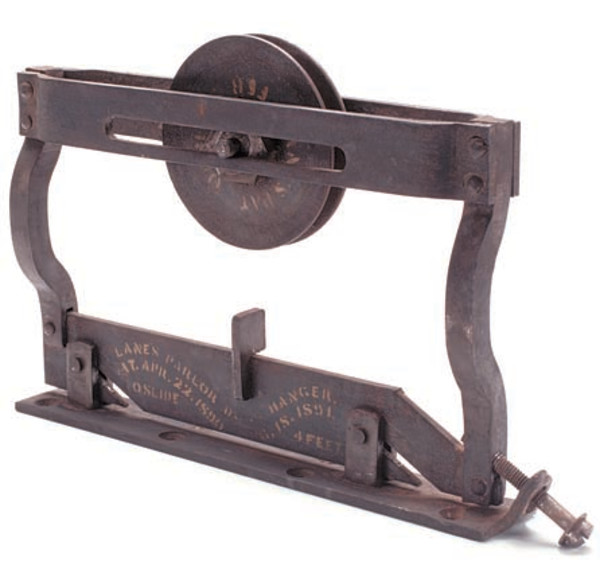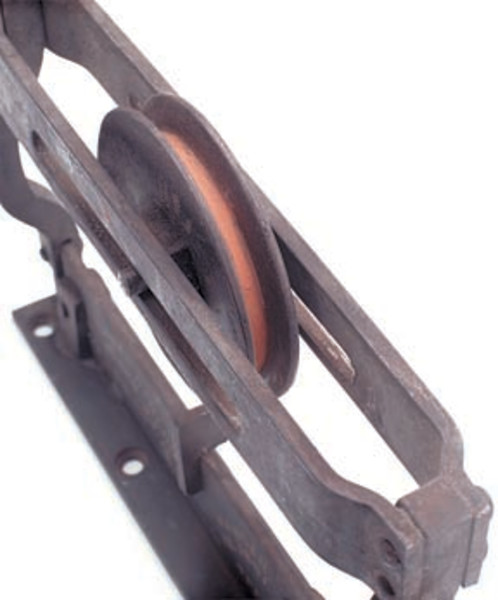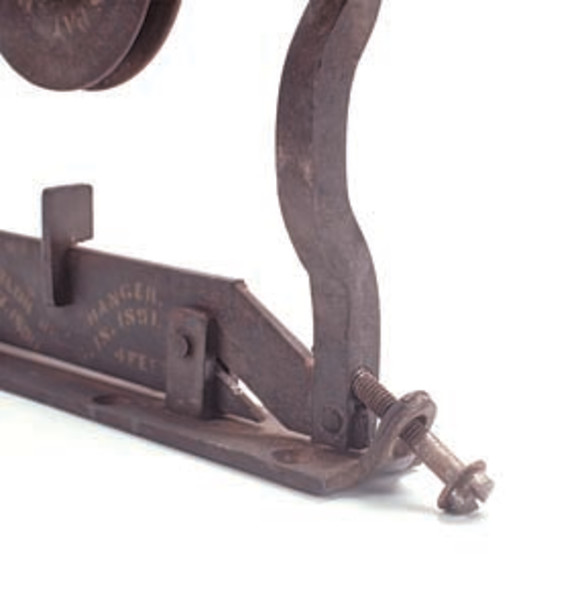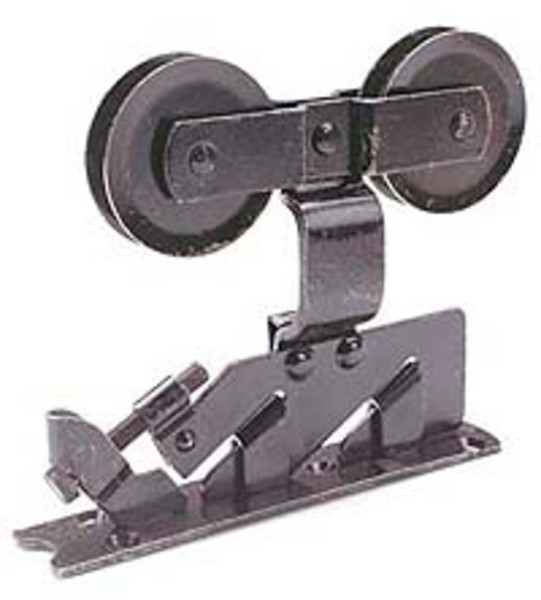
The Lane’s Parlor Door Hanger (patented in 1890 and ’91) is attached in pairs to the tops of many gaslight-era pocket doors.
Pocket doors separate the parlors and dining rooms of thousands of row houses, and top-hung rollers are the hardware that brought these doors to new levels of performance and popularity in the late 19th century. Taking a closer look at one of the most common hangers—the single iron-bar track type—helps explain why.
Mechanical Improvements
Though pocket doors were common as early as the 1850s, most of them used V-rollers (sheaves) that were in the bottom of the door and ran on a track on the floor—a system that grew noisy or difficult to operate if the floor sagged. Shifting the track and moving hardware to the top of the door circumvented this problem, and by the 1880s there were several patented top-hung hardware systems on the market. One of the leaders of the industry was Lane Brothers of Poughkeepsie, New York. Though many hangers of the era simply suspended the door by two flat-rimmed iron wheels that ran on a pair of wooden rails (intended to dampen noise), Lane devised a novel system that used a single roller running on a single rail of steel bar that was easier to install (attaching to only one side of the partition), easier to use (due to reduced bearing surface), and less likely to warp or wear.

The core of the Lane sheave is actually leather or fiber that cushions the ride on the metal rail.
Lane also broke new ground with its sheave-and-axle design, one it claimed was “noiseless” in 1889 advertising. Instead of just permanently riveting the sheave to the hanger frame in a simple axle, Lane enclosed it in a slotted mini-track that allowed it to travel back and forth as the door moved. In the days before roller and ball bearings were ubiquitous, this principle greatly reduced friction and allowed the door to glide on the track with a minimum of resistance—a tremendous asset for large oak or mahogany doors that might weigh 200 pounds or more.
Below the hanger proper, Lane also incorporated a clever slotted mount that permitted adjusting the height, floor clearance, and hanging angle of the door by turning a screw. Though the system was designed so that doors could be removed by lifting both door and hanger off the track at one time, backing the screw out completely would also do the job.

Turning the screw on the front hanger adjusts the door angle and the gap between mating doors. Also turning the screw on the back hanger (trickier to reach) adjusts the door-to-floor clearance.
A Rolling Industry
Though Lane introduced less complicated sliding-door hardware in the mid-1890s, the Steel Parlor Door Hanger was clearly its flagship product, and it appears to have been in production at least through the ‘teens, with and without the slotted-bearing device. In fact, in what was then a highly competitive business, Lane had at least two close imitators. By 1906 the Richards company was offering an all-steel Seal model sliding door hanger that reprised each of the basic features of Lane design, while in 1913 the Lundy Hanger was using the same slotted bearing on a simple threaded base.
The Wilcox Manufacturing Company of Aurora, Illinois, was yet another player in this dog-eat-dog industry at the turn of the 20th century, and come the boom building years of the 1920s one could buy a set of pocket-door hangers by the now merged Richards-Wilcox Company with double wheels and modern bearings that was a further reduced form of the Lane unit—a testament perhaps to the enduring quality of the original design.
A century later, hundreds—maybe thousands—of single-rail top-hung hangers carry on long past the days of their original makers. Even more may be returned to fresh or better service in old houses by investigating a few of their specific care and installation points.

After 1900, pocket-door hardware manufacturers took increasing advantage of economical roller and ball bearings. This Richards-Wilcox hanger (1920s) attaches a pair of fixed wheels to a hanger base essentially the same as Lane’s from the 1880s.
- Note that an essential part of the original Lane Steel Door Hanger and even competitors, such as the Richard’s Seal hanger, is a “tire” at the bottom of the sheave V. Actually leather or fiber sandwiched between the two halves of the sheave before they are riveted together, it is designed to cushion and quiet the movement of the hanger on the track. If you have a door that is noisy or difficult to operate, check to see if this material is missing, then replace it with a suitable substitute.
- Note as well that the hangers with the frictionless slotted-bearing design must be sized to the door. Look for a door size stamped somewhere on the hanger. If the wrong size hanger is installed (either as a replacement, or in some cases originally), the wheel will not be able to travel the necessary distance and may cause the door to balk or, with repeated abuse, wear away the end of the slot and freeze up the sheave.
- Stops are all important in slotted-bearing hangers to keep the door from traveling beyond the designed limits of the hardware. Look for manufacturer-made stops that attach to the rail and adjust accordingly. Also consider adding your own stops at the back of the door pocket to make sure the door does not overrun its limits. Use two wood blocks covered in, say, EPDM rubber scraps, placing them at both the top and bottom of the door.
Learn more about pocket door repair.
Special thanks to the folks at Wm. J. Rigby Company for technical help with this article.







